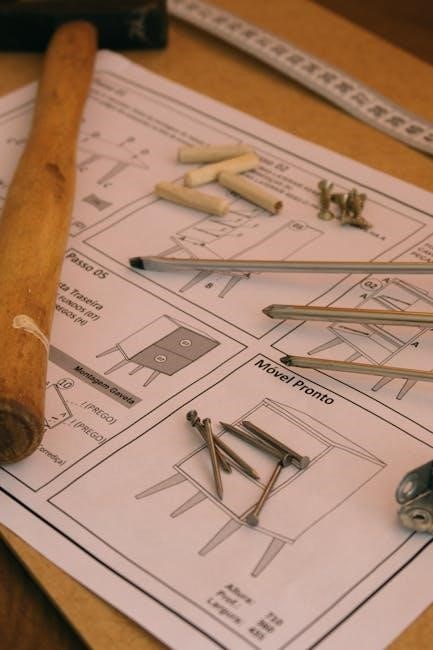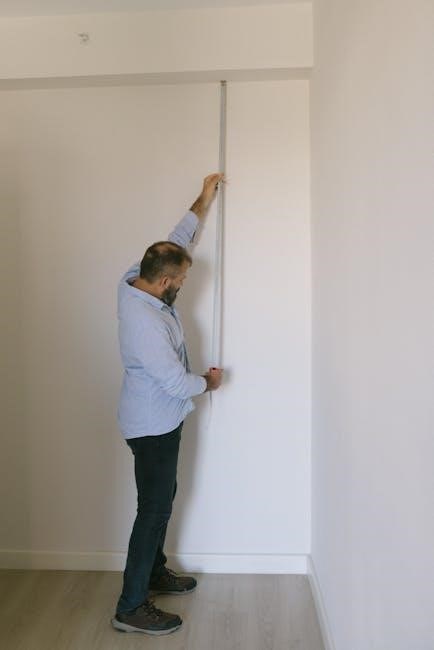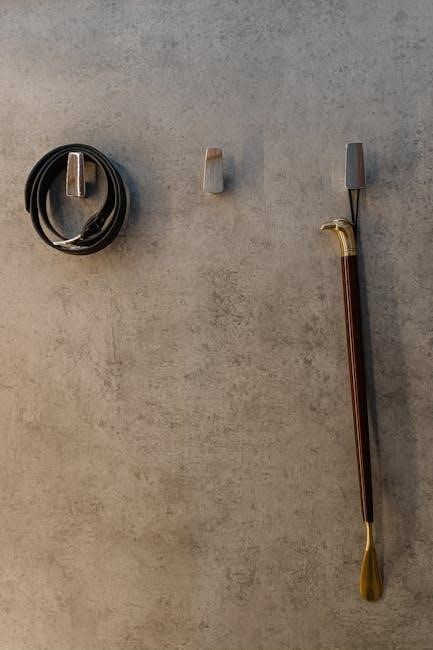shirt measure guide

Understanding proper shirt measurement is crucial for ensuring a perfect fit, enhancing comfort, and achieving a polished appearance. A shirt measure guide serves as a practical tool for individuals and tailors to determine accurate sizing, ensuring consistency across different brands and styles. By mastering these measurements, you can confidently select shirts that align with your body type and personal style preferences, avoiding unnecessary returns and alterations.
1.1 Importance of Accurate Measurements
Accurate shirt measurements are essential for ensuring a perfect fit, eliminating the need for costly alterations or returns. Proper measurements guarantee comfort, flattering silhouette, and optimal performance of the garment. Misfit shirts can restrict movement, appear unprofessional, or feel uncomfortable, making precise measurements crucial. Whether for ready-to-wear or custom-made shirts, understanding your measurements ensures confidence and satisfaction. Additionally, accurate sizing aids in maintaining consistent fit across brands, which often vary in measurement standards. By mastering shirt measurements, you can make informed purchases and tailor your wardrobe to your unique body type, enhancing both style and functionality.
1.2 Purpose of a Shirt Measure Guide
A shirt measure guide is designed to help individuals achieve the perfect fit by providing clear, step-by-step instructions for measuring key areas of the body and the shirt itself. Its primary purpose is to solve common fit issues, such as tightness or looseness, by offering customization options like sleeve length and stomach fit. The guide also empowers users to make informed purchasing decisions, ensuring their chosen shirt aligns with their body type and personal style. By following the guide, customers can avoid sizing mismatches and enjoy a tailored fit, whether they’re shopping off the rack or ordering custom-made shirts.

Understanding Body Measurements

Body measurements are essential for determining shirt size, ensuring a comfortable and flattering fit. They help identify key areas like chest, shoulders, and waist, guiding accurate sizing decisions.
2.1 Chest Circumference Measurement
The chest circumference is a critical measurement for determining shirt size. To measure accurately, wrap a flexible tape measure around the fullest part of your chest, keeping it level and parallel to the floor. Ensure the tape is snug but not tight, with your arms relaxed by your sides. This measurement helps determine the shirt’s fit across the torso, ensuring comfort and proper drape. For men, this is typically taken 1 inch below the armpits, while for women, it’s measured around the bust. Accurate chest measurement ensures the shirt fits well and maintains a flattering silhouette.

2.2 Shoulder Width Measurement
Shoulder width is measured across the back, from the tip of one shoulder to the tip of the other, ensuring the tape measure remains level and parallel to the floor. This measurement is essential for determining how the shirt will fit across the upper body. For accuracy, measure from the base of the neck on one side to the base of the neck on the other, keeping the tape snug but not tight. Proper shoulder fit ensures comfort and prevents the shirt from feeling too tight or sagging. Variations may exist between brands, so consistency with the company’s measurement method is key.
2.3 Waistline Measurement
The waistline measurement is taken at the narrowest point of the natural waist, typically just above the hipbone, ensuring the tape is snug but not constricting. This measurement helps determine the shirt’s fit around the midsection, especially for tailored or slim-fit styles. To measure accurately, stand upright and wrap the tape around the torso, keeping it level and parallel to the floor. For shirts, this measurement is often used to ensure the garment isn’t too tight or too loose, providing a comfortable fit that complements the body’s shape. Consistency is key, as methods may vary slightly between brands and tailors.
2.4 Hip Measurement
The hip measurement is taken around the widest part of the hips, typically 7-9 inches below the waistline. This measurement helps determine how well the shirt fits around the lower torso, ensuring comfort and proper drape. To measure accurately, stand upright and wrap the tape around the fullest part of the hips, keeping it level and parallel to the floor. For shirts, this measurement is particularly important for styles that taper or flare, ensuring the fit is balanced and flattering. Consistent measurement techniques are crucial for accuracy, as variations can affect how the shirt sits on the body.

Measuring the Shirt
Measuring a shirt involves assessing key areas like chest, shoulders, sleeves, and length. Lay the shirt flat, smooth wrinkles, and use a tape measure for accuracy. Consistency ensures the best fit.
3.1 Chest Measurement on the Shirt
Measuring the chest of a shirt is essential for determining its fit. Lay the shirt flat on a sturdy surface, ensuring it is buttoned and smooth. Locate the armpits and measure 1 inch below them, across the chest from one side seam to the other. This provides the chest circumference. For consistency, take the measurement twice and average the results. If using a flexible tape measure, ensure it is taut but not stretched. This measurement helps match the shirt to your body, ensuring comfort and proper sizing. Accurate chest measurement is foundational for achieving the perfect fit in any shirt style.
3.2 Shoulder Fit Measurement
Measuring the shoulder fit of a shirt ensures proper alignment and comfort. Lay the shirt flat on a sturdy surface, ensuring it is buttoned and smooth. Identify the shoulder seams, which run from the base of the collar to the top of the sleeve. Measure the distance between the two shoulder seams, ensuring the tape measure is straight and parallel to the ground. This measurement determines how the shirt will sit on your shoulders. A well-fitted shoulder measurement prevents the shirt from being too tight or too loose, contributing to a balanced and comfortable fit. Accurate shoulder fit is key to a polished appearance.
3.3 Sleeve Length Measurement
To measure sleeve length accurately, start by laying the shirt flat with the back side facing up. Smooth out any wrinkles to ensure precise measurement. Locate the shoulder seam and measure straight down to the end of the cuff. Ensure the tape measure remains straight and parallel to the shirt’s length. This measurement determines how the sleeves will fit on your arms. For a tailored look, the cuff should reach the base of your thumb when your arms are slightly bent. Accurate sleeve length ensures comfort and a polished appearance, making it a critical factor in achieving the perfect shirt fit.
3.4 Stomach Fit Measurement
Measuring the stomach fit involves assessing how the shirt fits around your midsection; To do this accurately, lay the shirt flat with the back side facing up and smooth out any wrinkles. Locate the midpoint between the armhole and the bottom hem. Measure across the shirt at this point, ensuring the tape measure is straight and not sagging. This measurement helps determine the comfort and appearance of the shirt, avoiding a too-tight or overly loose fit. Comparing this measurement to a well-fitting shirt can guide your size selection, keeping in mind potential variations between brands. Accurate stomach fit ensures optimal comfort and style.
3.5 Overall Shirt Length Measurement
To measure the overall shirt length, lay the shirt flat with the back side facing up. Locate the neckband seam at the top and measure straight down to the bottom hem. This measurement determines how the shirt will fit in relation to your body, whether tucked or untucked. For untucked shirts, the length should reach mid-fly or slightly below, while tucked shirts need enough length to stay in place when moving. Consider your height, belly size, and intended use when selecting the ideal length. This ensures the shirt drapes correctly, maintaining both comfort and style. Accurate length measurement ensures a flattering and functional fit.

Comparing Measurements to Size Charts
Comparing your measurements to size charts ensures a perfect fit. Match chest, shoulder, sleeve, and waist measurements to the chart, considering any variances between brands for accuracy.
4.1 Matching Chest and Shoulder Measurements
Accurate chest and shoulder measurements are vital for determining shirt size. Measure the chest 1 inch below the armholes and compare it to the size chart. Shoulder width is measured from seam to seam. Ensure both measurements align with the chart. If they differ, prioritize shoulder fit for comfort. This ensures the shirt sits well on the body, avoiding restrictive or overly loose fits. Proper alignment enhances both appearance and comfort, making it essential for a tailored look. Always refer to the specific brand’s chart, as sizing can vary slightly between manufacturers. This step guarantees a precise and comfortable fit every time.
4.2 Adjusting for Sleeve Length
Sleeve length is measured from the shoulder seam to the cuff. To ensure accuracy, combine this measurement with half of your shoulder width. For example, if your sleeve measures 25 inches and half your shoulder width is 9.5 inches, the total sleeve length is 34.5 inches. Consider your height and whether you plan to tuck the shirt in. Taller individuals may need longer sleeves, while shorter individuals might prefer shorter lengths. Adjustments should align with your body proportions for a balanced look. Always compare your measurements to the brand’s size chart, as sleeve length can vary slightly between manufacturers. This ensures the perfect fit and comfort.
4.3 Determining Stomach Fit Options
Stomach fit is measured around the navel area, with options varying by 1 inch across the shirt. To determine your fit, measure a best-fitting shirt halfway between the armhole and bottom hem. Lay the shirt flat, smooth out wrinkles, and measure across the midsection. Compare this to the size chart to select from available options. If you prefer a slimmer fit, choose a narrower measurement; for comfort, opt for a slightly looser fit. This ensures the shirt drapes naturally around your torso, providing comfort and a flattering silhouette. Adjustments can be made based on personal preference or body type for optimal comfort and appearance.
4.4 Selecting Overall Length Options
Overall shirt length is measured from the neckband seam to the bottom hem. To determine your ideal length, consider how you plan to wear the shirt—tucked or untucked. For untucked styles, the hem should reach mid-zipper of your pants. For tucked shirts, ensure enough length to stay tucked when reaching up. Measure a well-fitting shirt from the neckband to hem and compare to the size chart. Length options vary, with choices like Shorter, Standard, or Longer. Your height, belly size, and personal style influence this choice. Selecting the right length ensures comfort and a flattering fit, tailored to your preferences and needs.

Frequently Asked Questions
What are the key measurements for shirt sizing? Chest, shoulders, sleeve length, and waist are essential for a perfect fit. Measure these accurately using a flexible tape measure.
How do I measure sleeve length accurately? Start at the shoulder seam, go down to the cuff, ensuring the tape is straight and not twisted for precise measurement.
Can I use my best-fitting shirt as a reference? Yes, measure your best-fitting shirt across the chest, shoulders, and sleeves to match it to a size chart effectively.
5.1 What Are the Key Measurements for Shirt Sizing?
The key measurements for shirt sizing include chest circumference, shoulder width, sleeve length, waistline, and hip measurement. Chest measurement is taken 1 inch below the armholes, ensuring the tape is level and snug. Shoulder width is measured from one shoulder tip to the other, ensuring accuracy for a comfortable fit. Sleeve length is measured from the shoulder seam to the cuff, while waist and hip measurements are taken at their narrowest and widest points, respectively. These measurements help determine the perfect fit, ensuring comfort and style. Accurate measurements are essential for matching to size charts and achieving a tailored look.

5.2 How Do I Measure Sleeve Length Accurately?

To measure sleeve length accurately, start by laying the shirt flat with the front side facing up. Locate the shoulder seam and measure straight down to the cuff. Ensure the tape measure is taut but not stretched. For tailored fits, combine this measurement with half of your shoulder width for optimal sleeve proportion. Smooth out any wrinkles to avoid inaccuracies. If measuring a fitted shirt, account for any tapering near the cuff. Record the measurement to the nearest 1/4 inch for precision. This ensures the sleeves complement your body proportions, providing comfort and a polished appearance.
5.3 Can I Use My Best-Fitting Shirt as a Reference?
Yes, using your best-fitting shirt as a reference is an effective way to ensure accurate measurements. Lay the shirt flat on a firm surface, smoothing out any wrinkles. Measure key points like chest, shoulders, and sleeves, and compare these to the brand’s size chart. This method helps maintain consistency and reduces sizing errors. However, be aware that fit preferences and fabric types can vary, so slight adjustments may be needed. Regularly updating your measurements ensures the best fit over time. This approach is particularly useful when ordering custom shirts or alterations, saving time and effort in achieving your desired fit.

Mastering shirt measurements is a simple yet impactful step toward achieving a flawless fit. By understanding key measurements like chest, shoulders, and sleeve length, you can confidently select shirts that align with your body type. Using a best-fitting shirt as a reference ensures accuracy and consistency. Remember, proper fit enhances comfort, style, and confidence. Whether shopping online or tailoring a custom shirt, these guidelines provide a reliable foundation. Regularly updating your measurements and comparing them to size charts will help you maintain the perfect fit over time. With practice, you’ll effortlessly find shirts that feel tailored to your unique proportions.



Leave a Reply
You must be logged in to post a comment.